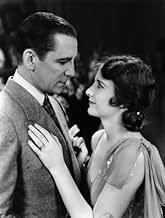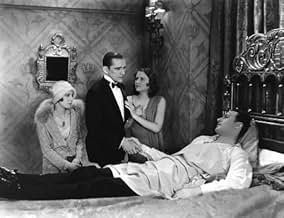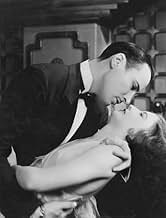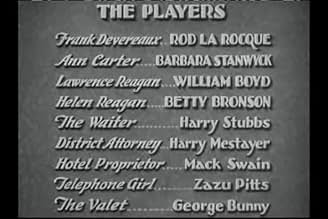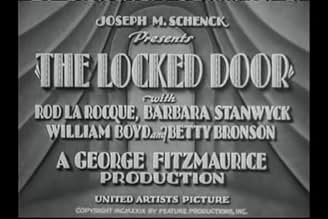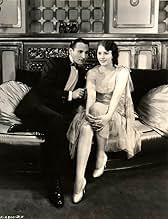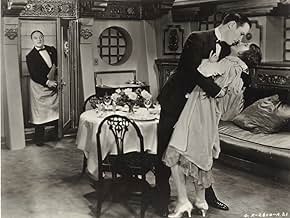IMDb RATING
6.0/10
642
YOUR RATING
On her first anniversary, Ann Reagan finds that her sister-in-law is involved with a shady character from her own past, and determines to intervene.On her first anniversary, Ann Reagan finds that her sister-in-law is involved with a shady character from her own past, and determines to intervene.On her first anniversary, Ann Reagan finds that her sister-in-law is involved with a shady character from her own past, and determines to intervene.
Zasu Pitts
- Telephone Girl
- (as Zazu Pitts)
Mary Ashcraft
- Girl on Rum Boat
- (uncredited)
Violet Bird
- Girl on Rum Boat
- (uncredited)
Earle Browne
- Bit Part
- (uncredited)
Clarence Burton
- Police Officer
- (uncredited)
Lita Chevret
- Girl on Rum Boat
- (uncredited)
Gilbert Clayton
- Bit Part
- (uncredited)
Pauline Curley
- Bit Part
- (uncredited)
Edgar Dearing
- Cop
- (uncredited)
Edward Dillon
- Bit Part
- (uncredited)
Featured reviews
The attraction here is not just Barbara Stanwyck, even though it's her first talkie and she handles her role with a secure professionalism that belies her cinematic inexperience. Born for the camera she was! But an equally impressive performance is delivered by Rod La Rocque as the serial cad who mistreats her and then sets his sights on her younger sister. The trappings are typical 20's soap opera/melodrama, in this case derived from a stage play. But not typical for the era is La Rocque's well-tailored villain who seems to have stepped out of a story from a much later era; in fact, his performance would not be considered one bit dated even by today's standards - highly unusual for a film from 1929. His line readings and body language bespeak a decadent, spoiled rogue without a scintilla of conscience, all of this enhanced by delicately tapered sideburns. He also has a smooth, deep speaking voice. The look and style of the film are standard for the era but include an interesting, lively panoramic dance party sequence on a "drinking boat" (pleasure boats that sailed outside the 12-mile limit of the US coast so the patrons could drink alcohol illegally during the Prohibition era) intercut with an intimate scene between Stanwyck and La Rocque in one of the cabins.
BARBARA STANWYCK was never too fond of her first talkie and it's easy to see why. Filmed at a time when stage actors were just getting familiar with sound technique in films, it has a multitude of problems with regard to script, direction and performances.
ROD LaROCQUE is insufferably hammy as the bad guy who tries to seduce Stanwyck aboard an illegal rum boat and turns up some eighteen months later paying court to her sister (BETTY BRONSON). Stanwyck and hubby WILLIAM BOYD decide to stop LaRocque from carrying through with his plans to run off with Bronson and the plot thickens, going from one melodramatic mess to another before the story crawls to an end.
Best aspect of the film is the photography of Ray June, especially the overhead shots looking through the glass ceiling of a dance floor on the riverboat and the panning shot of bar customers ordering drinks.
Everyone sounds like they're reading their lines for a run through rehearsal, but Stanwyck at least shows emotion well in some good close-ups. Bronson and LaRocque are the worst with the new mikes.
ROD LaROCQUE is insufferably hammy as the bad guy who tries to seduce Stanwyck aboard an illegal rum boat and turns up some eighteen months later paying court to her sister (BETTY BRONSON). Stanwyck and hubby WILLIAM BOYD decide to stop LaRocque from carrying through with his plans to run off with Bronson and the plot thickens, going from one melodramatic mess to another before the story crawls to an end.
Best aspect of the film is the photography of Ray June, especially the overhead shots looking through the glass ceiling of a dance floor on the riverboat and the panning shot of bar customers ordering drinks.
Everyone sounds like they're reading their lines for a run through rehearsal, but Stanwyck at least shows emotion well in some good close-ups. Bronson and LaRocque are the worst with the new mikes.
Stagy but clever murder mystery with Barbara Stanwyck in her talkie debut and the center of attention.
The copy I have has a missing scene but this is still an effective if stagy and slightly hammy film.
Stanwyck is a secretary who goes to a boat party with the boss's son and maybe gets raped (that scene is missing) and raided by the police. She and the son skip bail and disappear. 18 months later we find Stanwyck happily married to a wealthy man (William Boyd) when his sister's new boy friend shows up. Yup it's the sleazy son (Rod LaRocque) with a new name. The sister (Betty Bronson) is gaga over him but Stanwyck is horrified.
Stanwyck overhears their plans to run off to Honolulu so she decides to pay LaRocque a visit. But unbeknown to her, her husband is also planning a visit because he has been warned about the boy friend.
Stanwyck arrives at LaRocque's apartment and starts a fight but is interrupted when the husband arrives. The guys scuffle and a gun goes off. Husband leaves and locks the door, trapping Stanwyck (hiding in a bedroom) in the apartment with the corpse. She thinks fast, rips her dress and calls the operator, pretending to fend off an attacker and firing the gun.
Both Stanwyck and Boyd eventually admit to the killing but then Bronson shows up.....
Supporting cast includes Zasu Pitts as the operator, Mack Swain as the manager, George Bunny as the valet, Purnell Pratt is a police man, and Harry Stubbs is the surprising waiter.
Neat little film apparently lost for decades.
The copy I have has a missing scene but this is still an effective if stagy and slightly hammy film.
Stanwyck is a secretary who goes to a boat party with the boss's son and maybe gets raped (that scene is missing) and raided by the police. She and the son skip bail and disappear. 18 months later we find Stanwyck happily married to a wealthy man (William Boyd) when his sister's new boy friend shows up. Yup it's the sleazy son (Rod LaRocque) with a new name. The sister (Betty Bronson) is gaga over him but Stanwyck is horrified.
Stanwyck overhears their plans to run off to Honolulu so she decides to pay LaRocque a visit. But unbeknown to her, her husband is also planning a visit because he has been warned about the boy friend.
Stanwyck arrives at LaRocque's apartment and starts a fight but is interrupted when the husband arrives. The guys scuffle and a gun goes off. Husband leaves and locks the door, trapping Stanwyck (hiding in a bedroom) in the apartment with the corpse. She thinks fast, rips her dress and calls the operator, pretending to fend off an attacker and firing the gun.
Both Stanwyck and Boyd eventually admit to the killing but then Bronson shows up.....
Supporting cast includes Zasu Pitts as the operator, Mack Swain as the manager, George Bunny as the valet, Purnell Pratt is a police man, and Harry Stubbs is the surprising waiter.
Neat little film apparently lost for decades.
Locked Door, The (1929)
** (out of 4)
Dry crime melodrama about a woman (Barbara Stanwyck) who gets herself arrested while on a rum boat with the lavish Frank Devereaux (Rod La Rocque). Eighteen months later she is married to another man (William Boyd) but she soon learns that his sister is now involved with Frank. This early talkie from United Artist has pretty much been forgotten with the exception that it will stand the test of time as being Stanwyck's first major role as her previous film had her in a bit role. As with many early talkies, the technology leaves a lot to be desired and I can't help but think that the director wasn't too worried with what was happening on the screen as he was making sure everyone could hear what was going on. The film is incredibly dry of any humor, suspense or drama and that's a real shame because the story is actually pretty good as all four characters get involved with a possible murder towards the end of the film. This murder happens an hour into a 74-minute film so the payoff comes rather quickly but the ending is certainly the best thing about the movie. Stanwyck comes off fairly good in her role but there's no doubt she still had some rust around the edges. La Rocque comes off incredibly over the top as if he was playing in some sort of strange comedy and I can only compare him to what people would see decades later in John Waters. Boyd is pretty good in his role and actually steals the film, although Zasu Pitts has a few good scenes as a telephone operator.
** (out of 4)
Dry crime melodrama about a woman (Barbara Stanwyck) who gets herself arrested while on a rum boat with the lavish Frank Devereaux (Rod La Rocque). Eighteen months later she is married to another man (William Boyd) but she soon learns that his sister is now involved with Frank. This early talkie from United Artist has pretty much been forgotten with the exception that it will stand the test of time as being Stanwyck's first major role as her previous film had her in a bit role. As with many early talkies, the technology leaves a lot to be desired and I can't help but think that the director wasn't too worried with what was happening on the screen as he was making sure everyone could hear what was going on. The film is incredibly dry of any humor, suspense or drama and that's a real shame because the story is actually pretty good as all four characters get involved with a possible murder towards the end of the film. This murder happens an hour into a 74-minute film so the payoff comes rather quickly but the ending is certainly the best thing about the movie. Stanwyck comes off fairly good in her role but there's no doubt she still had some rust around the edges. La Rocque comes off incredibly over the top as if he was playing in some sort of strange comedy and I can only compare him to what people would see decades later in John Waters. Boyd is pretty good in his role and actually steals the film, although Zasu Pitts has a few good scenes as a telephone operator.
George Fitzmaurice was one of the great commercial stylists among directors in the 1920s. He suffered an eclipse in the early talkie era but was fighting his way back into the majors when he died in 1940.
This means, of course, there are a lot of problems with this movie. The screen actors don't know how to do dialogue and most of the stage actors don't know how to turn down their performances for the intimacy of the movie camera. Barbara Stanwyck, looking very fresh-faced, is very loud in her line readings. She knows how to show her emotions beautifully already, though.
But producer Joe Schenck didn't spare any expense behind the camera, and it shows. Avant-garde cameraman Ray June handles the camera impeccably. While other directors were having their cameramen use cuts to change subjects, Fitzmaurice has June move the camera. Notice the long tracking shot at the bar in the opening sequence and the MOS shots used to fill out the sequence.
The camera-work is not fluid. It is, frankly, fairly clunky, but it is light years ahead of anyone else in the business in 1929, except possibly Mamoulian's APPLAUSE.
So while their are a lot of problems with this movie, the camera-work makes this one very superior for 1929 and Barbara Stanwyck makes it worth looking at.
This means, of course, there are a lot of problems with this movie. The screen actors don't know how to do dialogue and most of the stage actors don't know how to turn down their performances for the intimacy of the movie camera. Barbara Stanwyck, looking very fresh-faced, is very loud in her line readings. She knows how to show her emotions beautifully already, though.
But producer Joe Schenck didn't spare any expense behind the camera, and it shows. Avant-garde cameraman Ray June handles the camera impeccably. While other directors were having their cameramen use cuts to change subjects, Fitzmaurice has June move the camera. Notice the long tracking shot at the bar in the opening sequence and the MOS shots used to fill out the sequence.
The camera-work is not fluid. It is, frankly, fairly clunky, but it is light years ahead of anyone else in the business in 1929, except possibly Mamoulian's APPLAUSE.
So while their are a lot of problems with this movie, the camera-work makes this one very superior for 1929 and Barbara Stanwyck makes it worth looking at.
Did you know
- TriviaOther than one bit part, this is Barbara Stanwyck's feature film debut.
- Quotes
Frank Devereaux: Shoot yourself in the head, and if you live, you can become a Waiter.
- ConnectionsFeatured in Visions of Light (1992)
- SoundtracksI've Got a Feeling I'm Falling
(uncredited)
Written by Fats Waller and Harry Link
First tune played on the boat
- How long is The Locked Door?Powered by Alexa
Details
- Release date
- Country of origin
- Language
- Also known as
- The Locked Door
- Production company
- See more company credits at IMDbPro
- Runtime
- 1h 14m(74 min)
- Color
- Aspect ratio
- 1.20 : 1
Contribute to this page
Suggest an edit or add missing content

